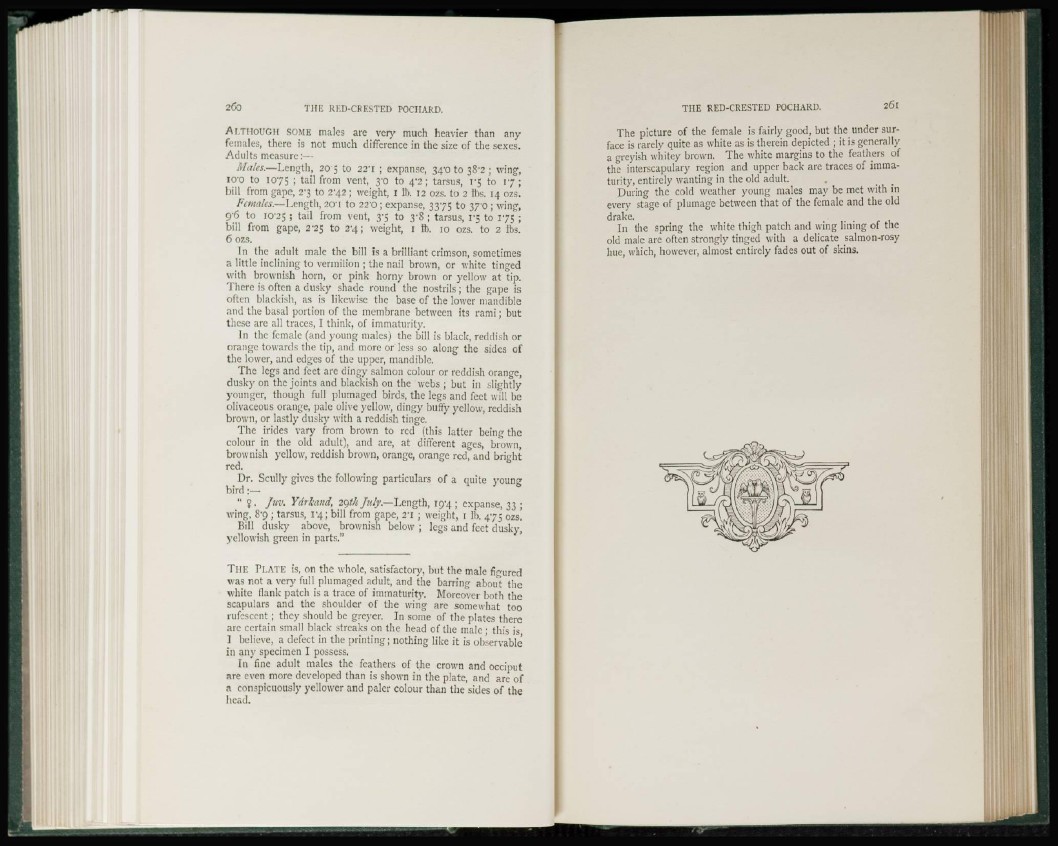
ALTHOUGH SOME males are very much heavier than any
females, there is not much difference in the size of the sexes.
Adults measure:—
Males.—Length, 20 5 to 22T ; expanse, 34/0 to 38-2 ; wing,
IO'O to 1075 ; tail from vent, 30 to 4'2 ; tarsus, 1-5 to 17 ;
bill from gape, 2'3 to 24.2 ; weight, I It). 12 ozs. to 2 lbs. 14 ozs.
Females.—Length, 201 to 22'0 ; expanse, 3375 to 370 ; wing,
96 to 10-25 > t a ' ' fr o r n vent, 3-5 to 3-8 ; tarsus, 1-5 to 1-75 ;
bill from gape, 2-25 to 24; weight, 1 lb. 10 ozs. to 2 lbs.
6 ozs.
In the adult male the bill is a brilliant crimson, sometimes
a little inclining to vermilion ; the nail brown, or white tinged
with brownish horn, or pink horny brown or yellow at tip.
There is often a dusky shade round the nostrils; the gape is
often blackish, as is likewise the base of the lower mandible
and the basal portion of the membrane between its rami; but
these are all traces, I think, of immaturity.
In the female (and young males) the bill is black, reddish or
orange towards the tip, and more or less so along the sides of
the lower, and edges of the upper, mandible.
The legs and feet are dingy salmon colour or reddish orange,
dusky on the joints and blackish on the webs ; but in slightly
younger, though full plumaged birds, the legs and feet will be
olivaceous orange, pale olive yellow, dingy buffy yellow, reddish
brown, or lastly dusky with a reddish tinge.
The irides vary from brown to red (this latter being the
colour in the old adult), and are, at different ages, brown,
brownish yellow, reddish brown, orange, orange red, and bright
red.
Dr. Scully gives the following particulars of a quite young
bird :—
" J. Juv. Ydrkand, 2gfli July.—Length, 194 ; expanse, 33 ;
wing, 8-9 ; tarsus, 14; bill from gape, 2'I ; weight, 1 lb. 475 ozs.
Bill dusky above, brownish below ; legs and feet dusky,
yellowish green in parts."
THE PLATE is, on the whole, satisfactory, but the male figured
was not a very full plumaged adult, and the barring about the
white Hank patch is a trace of immaturity. Moreover both the
scapulars and the shoulder of the wing arc somewhat too
rufescent ; they should be gre3rer. In some of the plates there
are certain small black streaks on the head of the male ; this is,
] believe, a defect in the printing; nothing like it is observable
in any specimen I possess.
In'fine adult males the feathers of the crown and occiput
arc even more developed than is shown in the plate, and are of
a conspicuously yellower and paler colour than the sides of the
head.
The picture of the female is fairly good, but the under surface
is rarely quite as white as is therein depicted ; it is generally
a greyish whitey brown. The white margins to the feathers of
the interscapulary region and upper back are traces of immaturity,
entirely wanting in the old adult.
During the cold weather young males may be met with in
every stage of plumage between that of the female and the old
drake.
In the spring the white thigh patch and wing lining of the
old male are often strongly tinged with a delicate salmon-rosy
hue, which, however, almost entirely fades out of skins.